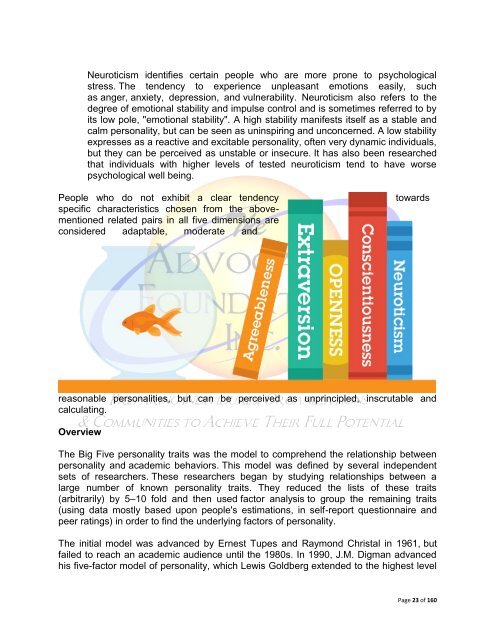The Gift of Introversion
The Gift of Introversion
The Gift of Introversion
You also want an ePaper? Increase the reach of your titles
YUMPU automatically turns print PDFs into web optimized ePapers that Google loves.
Neuroticism identifies certain people who are more prone to psychological<br />
stress. <strong>The</strong> tendency to experience unpleasant emotions easily, such<br />
as anger, anxiety, depression, and vulnerability. Neuroticism also refers to the<br />
degree <strong>of</strong> emotional stability and impulse control and is sometimes referred to by<br />
its low pole, "emotional stability". A high stability manifests itself as a stable and<br />
calm personality, but can be seen as uninspiring and unconcerned. A low stability<br />
expresses as a reactive and excitable personality, <strong>of</strong>ten very dynamic individuals,<br />
but they can be perceived as unstable or insecure. It has also been researched<br />
that individuals with higher levels <strong>of</strong> tested neuroticism tend to have worse<br />
psychological well being.<br />
People who do not exhibit a clear tendency<br />
specific characteristics chosen from the abovementioned<br />
related pairs in all five dimensions are<br />
considered adaptable, moderate and<br />
towards<br />
reasonable personalities, but can be perceived as unprincipled, inscrutable and<br />
calculating.<br />
Overview<br />
<strong>The</strong> Big Five personality traits was the model to comprehend the relationship between<br />
personality and academic behaviors. This model was defined by several independent<br />
sets <strong>of</strong> researchers. <strong>The</strong>se researchers began by studying relationships between a<br />
large number <strong>of</strong> known personality traits. <strong>The</strong>y reduced the lists <strong>of</strong> these traits<br />
(arbitrarily) by 5–10 fold and then used factor analysis to group the remaining traits<br />
(using data mostly based upon people's estimations, in self-report questionnaire and<br />
peer ratings) in order to find the underlying factors <strong>of</strong> personality.<br />
<strong>The</strong> initial model was advanced by Ernest Tupes and Raymond Christal in 1961, but<br />
failed to reach an academic audience until the 1980s. In 1990, J.M. Digman advanced<br />
his five-factor model <strong>of</strong> personality, which Lewis Goldberg extended to the highest level<br />
Page 23 <strong>of</strong> 160

















